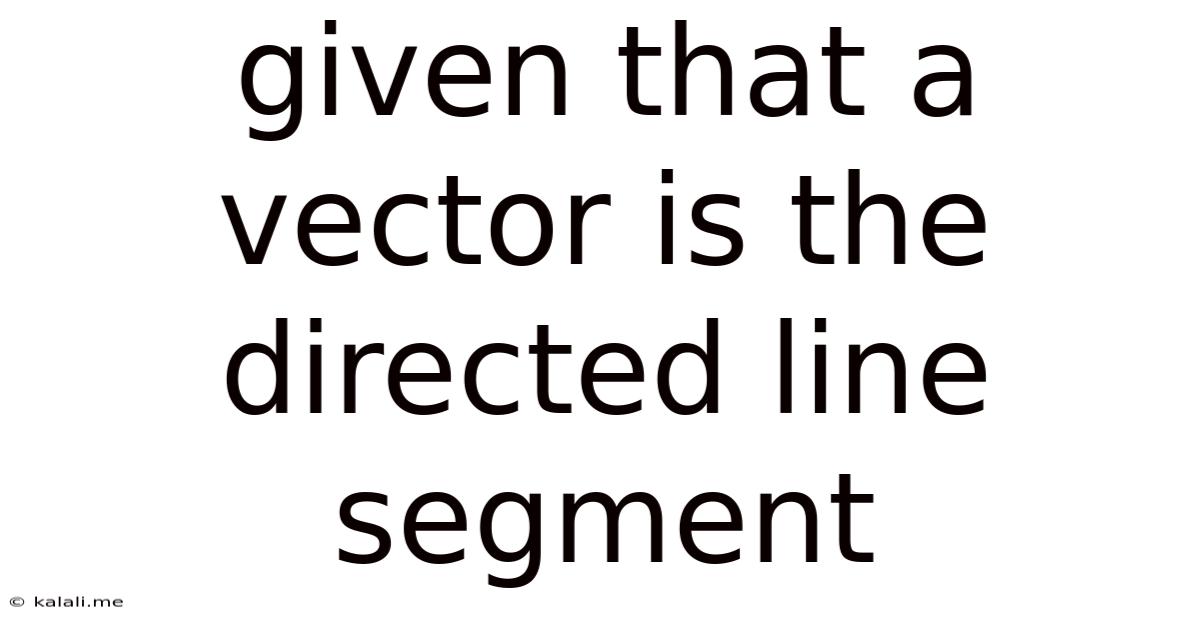Given That A Vector Is The Directed Line Segment
Kalali
Jun 10, 2025 · 3 min read

Table of Contents
Understanding Vectors: The Directed Line Segment
Vectors are fundamental mathematical objects with widespread applications in physics, engineering, computer graphics, and more. At its core, a vector is a directed line segment, meaning it has both magnitude (length) and direction. This article will delve into the key characteristics of vectors, exploring their representation, operations, and significance.
Understanding vectors begins with grasping the concept of a directed line segment. Unlike scalars, which only have magnitude (e.g., temperature, mass), vectors possess both magnitude and direction. This directionality distinguishes them and allows for representation in various forms. Think of an arrow: the length represents the magnitude, and the arrowhead indicates the direction.
Representing Vectors
Vectors can be represented in several ways:
- Geometrically: As a directed line segment in a coordinate system. The starting point (tail) and ending point (head) define the vector.
- Algebraically: Using components. In two dimensions, a vector is represented as
<x, y>, where 'x' and 'y' are the horizontal and vertical components respectively. In three dimensions, it's<x, y, z>. These components represent the change in coordinates from the tail to the head. - Using Unit Vectors: Vectors can also be expressed as a linear combination of unit vectors (vectors with magnitude 1). In a Cartesian coordinate system, the unit vectors are usually denoted as i, j, and k for the x, y, and z directions respectively. For example, the vector
<2, 3>can be written as 2i + 3j.
Key Vector Properties
Several properties define and characterize vectors:
- Magnitude (or length): Calculated using the Pythagorean theorem (or its extension in higher dimensions). For a 2D vector
<x, y>, the magnitude is √(x² + y²). - Direction: Defined by the angle the vector makes with a reference axis (typically the positive x-axis). This angle, often denoted as θ (theta), can be calculated using trigonometry.
- Equality: Two vectors are equal if they have the same magnitude and direction, regardless of their starting points.
- Addition and Subtraction: Vector addition involves combining vectors head-to-tail. Subtraction is the addition of the negative of a vector (same magnitude, opposite direction).
- Scalar Multiplication: Multiplying a vector by a scalar changes its magnitude but not its direction (unless the scalar is negative, in which case the direction is reversed).
Vector Operations and Applications
The ability to perform operations on vectors makes them incredibly powerful tools:
- Dot Product: This operation results in a scalar value, representing the projection of one vector onto another. It's useful for determining angles between vectors and finding work done by a force.
- Cross Product: This operation (defined only for 3D vectors) results in a new vector perpendicular to both original vectors. It's crucial in physics for calculating torque and angular momentum.
- Linear Combinations: Combining vectors using scalar multiplication and addition allows for representing any vector within a given vector space as a sum of other vectors. This is fundamental in linear algebra.
These operations are fundamental to many areas, including:
- Physics: Representing forces, velocities, accelerations, and fields.
- Computer Graphics: Defining positions, directions, and transformations of objects in 3D space.
- Engineering: Analyzing forces and stresses in structures.
- Machine Learning: Representing data points and features in high-dimensional spaces.
Conclusion
Vectors, fundamentally directed line segments, offer a powerful mathematical framework for representing and manipulating quantities with both magnitude and direction. Understanding their representation, properties, and operations is crucial for various scientific and engineering disciplines. Their ability to represent complex relationships in a concise and manageable way continues to make them an indispensable tool in numerous fields. Further exploration into linear algebra will deepen your understanding of the vast applications of vectors.
Latest Posts
Latest Posts
-
How Many Pounds Are In 2 5 Kg
Jul 01, 2025
-
Which Is Greater 2 3 Or 2 4
Jul 01, 2025
-
How Do You Pass Level 7 On Bloxorz
Jul 01, 2025
-
If Your 13 What Year Were You Born
Jul 01, 2025
-
How Many Cups Is 3 Liters Of Water
Jul 01, 2025
Related Post
Thank you for visiting our website which covers about Given That A Vector Is The Directed Line Segment . We hope the information provided has been useful to you. Feel free to contact us if you have any questions or need further assistance. See you next time and don't miss to bookmark.